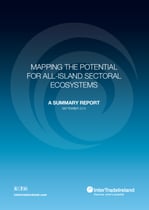Published: September 2015
Foreword
The potential benefits to arise from economic agglomeration, industrial districts or cluster development are widely researched and evidenced. In 2007 the OECD noted how ‘the cluster concept spread rapidly through policy circles in the 1990s and at both the national and regional levels the key concepts that underlie the cluster approach continue to be at the centre of policy formulation’. [1]
From a practical policy point of view the concept has influenced various initiatives from locational choices of inward investment to the development of business networks. In both Northern Ireland and the Republic of Ireland the development of clusters has had a considerable influence on policy. For example, in Ireland, Enterprise Ireland’s Pilot Clustering Programme has been in operation since 2012 and builds on earlier interventions designed to develop research and innovation networks, partnerships and flows of knowledge between businesses and other ecosystem actors. One of these, Science Foundation Ireland’s Strategic Research Clusters (run since 2006), specifically supports partnerships between higher education institutions (HEIs) and between HEIs and businesses.
In Northern Ireland, the clustering approach has underpinned Invest Northern Ireland’s Collaborative Business Networks programme, begun in 2009/10, which has seen the development of more than 30 networks. Furthermore funding from the EU cross-border INTERREG programmes has supported several cross-border business networks and clustering initiatives.
Such initiatives have forged better connections between businesses and between businesses and other actors in the ecosystem, such as trade associations, business development agencies,
financial services organisations and HEIs. Success stories include for example, the Global Wind Alliance and Digital Circle in Northern Ireland and in Ireland, IT@Cork and the emergence of a medical devices cluster around Galway with its interactions between multinationals, indigenous firms and HEIs.
The small size of the island and the proximity of businesses to one another and to other actors in the ecosystem suggest there are likely to be benefits to the development of all-island clusters or, to use the terminology in this report, sectoral ecosystems. The concept of sectoral ecosystems used here merges the spatial dimension behind cluster theory and practice with ideas about the web of relationships which have the firm at the centre interacting with other businesses, individuals and institutions for mutual benefit.
To date however, there has been little research on the potential benefits of all-island clustering or on the areas and sectors in which they can be developed. This report, which is based on a more detailed project commissioned by InterTradeIreland, seeks to begin this discussion. It proposes a framework which sets out how and what potential benefits can be expected from all-island sectoral ecosystems and using a new measurement index, it identifies and maps sectoral concentrations on an all-island basis. Finally, based on a detailed case study analysis of three prominent sectors, the report presents a series of potential opportunities which could enhance the development of new all-island sectoral ecosystems with mutual benefits for both jurisdictions. Realising these benefits will not be without its challenges but InterTradeIreland will now begin to assess how they might be delivered and the resources required to do so.
[1] OECD, Competitive Regional Clusters: National Policy Approaches (2007), p. 24.
 Click here to download the full report: Mapping the Potential for all-island Sectoral Ecosystems
Click here to download the full report: Mapping the Potential for all-island Sectoral Ecosystems
